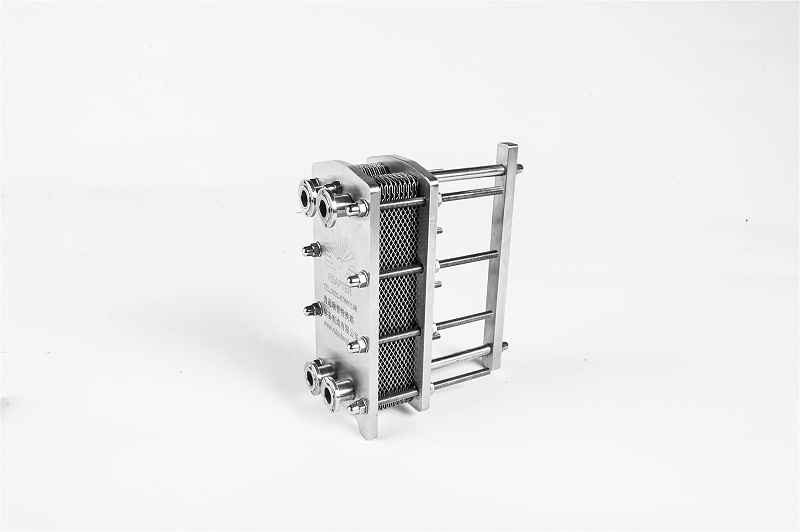Breakdown of application areas for plate heat exchangers
Plate heat exchanger has been widely used in metallurgy, mining, petroleum, chemical industry, electric power, medicine, food, chemical fiber, paper making, textile, shipbuilding, etc. It can be used for heating, cooling, evaporation, condensation, sterilization, waste heat recovery and other conditions. Solar energy utilization: It is involved in the heat transfer process of antifreeze such as ethylene glycol in the heat transfer medium of solar collector panel, so as to achieve the use of solar energy. Purpose.
Titanium oxide production, alcohol fermentation, ammonia synthesis, resin synthesis, rubber manufacturing, cooling phosphoric acid, cooling formaldehyde water, alkali carbon industry, electrolysis alkali production.
Iron and steel industry: cooling quenching oil, cooling electroplating fluid, cooling reducer lubricants, cooling rolling mill, wire drawing machine coolant.
Metallurgical industry: cooling of aluminate mother liquor heating, cooling of sodium aluminate, cooling of aluminum smelter lubricating oil.

Machinery manufacturing industry: all kinds of quenching liquid cooling, cold pressing, industrial machinery lubricating oil, heating machine oil. Food industry: salt, milk, soy sauce, vinegar sterilization, cooling, animal and vegetable oil heating, cooling, beer production beer, malt wort heating. Cooling, sugar, gelatin concentration, sterilization, cooling, sodium glutamate production.
Textile industry: heat recovery of various waste liquids, cooling of boiling phosphated fibers, cooling of viscose fibers, cooling of acetic acid and acetic anhydride, cooling of alkaline solutions, heating and cooling of viscose fibers.
Paper industry: cooling of black water, bleaching salts, lye heating, cooling, heat recovery of cellophane waste liquor, heating of digestive acids, cooling. Sodium hydroxide solution, recovery of bleached paper waste liquid, waste gas condensation, preheating of concentrated pulp as waste liquid. Centralized heat and thermal power plant waste heat area heating, domestic water heating, boiler area heating.
Petroleum industry: heating, cooling synthetic detergent, heating whale oil, cooling vegetable oil, cooling sodium hydroxide, cooling glycerin, emulsified oil.
Power industry: generator axial pump cooling, transformer oil cooling. Marine: diesel engines, central coolers, discharge coolers, piston coolers, lubricating oil coolers, preheaters, seawater desalination. System (including multi-stage and single-stage).
Seawater aquaculture and nursery: supporting boiler to raise the temperature of nursery seawater saves the use of coal, thus saving energy and improving environmental protection. Efficiency. Other: pharmaceutical, petroleum, ceramics, glass, cement, geothermal utilization, etc. plate heat exchanger Plate heat exchanger leaks are mainly manifested as leaks (small, discontinuous droplets) and leaks (large, continuous droplets).
*The main parts of the leaks are the seals between the plates, the leak slots in the second seal of the plates, and the interior of the end plates and pressure plates. The main characteristic of liquid crosstalk is that the media on the higher pressure side crosstalks into the media on the lower pressure side, and abnormal pressures can occur in the system and temperature. If the medium is corrosive, it may also cause corrosion of the plate heat exchanger gasket. Crosstalk usually occurs in the manifold or secondary seal area.
*Media with large pressure drops have inlet and outlet pressure drops that exceed the design requirements and are many times higher than the design values, significantly affecting system flow and temperature. requirements. In heating systems, if the pressure drop on the hot side is too great, the primary side flow will be severely inadequate, i.e., the heat source will not be sufficient, resulting in a secondary side temperature that cannot be Meet requirements. The main feature is that the outlet temperature is too low to meet the design requirements.
Related information
- What is the difference between the hanging holes on the plate heat exchanger plate? What's the effect on heat exchange?
- An article to take you to understand the structure of pharmaceutical and chemical plate heat exchanger and heat transfer
- Boiler supporting plate heat exchanger, how much do you know
- Plate heat exchanger for chemical industry
- Professional method of cleaning plate heat exchanger
- Qingdao Haier Group's extruder cooling and scaling problem has seriously affected production by plate heat exchanger
Relevant article
- Heat station supporting plate heat exchanger installation is a technical work, these points should be noted
- Sulfuric acid and other corrosive media for industrial plate heat exchanger requirements are what
- Simple and effective chemical cleaning method of coal chemical plate heat exchanger, can effectively improve efficiency
- A high-quality petrochemical plate heat exchanger in the production of what to consider
- These causes of chemical plate heat exchanger gasket aging you may not know
- Chemical plant plate heat exchanger, sulfuric acid cooling needs attention
- High-end plate heat exchanger customization, specifically for your special working conditions
- The working principle of gasket type industrial plate heat exchanger and the scenarios of its use are worth knowing in depth
- Still worrying about the wholesale price of industrial plate heat exchangers? An article to make you no longer tangled
- The original lubricant in the chemical plate heat exchanger plays so many roles!
Latest information
- Heat station supporting plate heat exchanger installation is a technical work, these points should be noted
- Sulfuric acid and other corrosive media for industrial plate heat exchanger requirements are what
- Simple and effective chemical cleaning method of coal chemical plate heat exchanger, can effectively improve efficiency
- A high-quality petrochemical plate heat exchanger in the production of what to consider
- These causes of chemical plate heat exchanger gasket aging you may not know
- Chemical plant plate heat exchanger, sulfuric acid cooling needs attention
- High-end plate heat exchanger customization, specifically for your special working conditions
- The working principle of gasket type industrial plate heat exchanger and the scenarios of its use are worth knowing in depth
- Still worrying about the wholesale price of industrial plate heat exchangers? An article to make you no longer tangled
- The original lubricant in the chemical plate heat exchanger plays so many roles!








